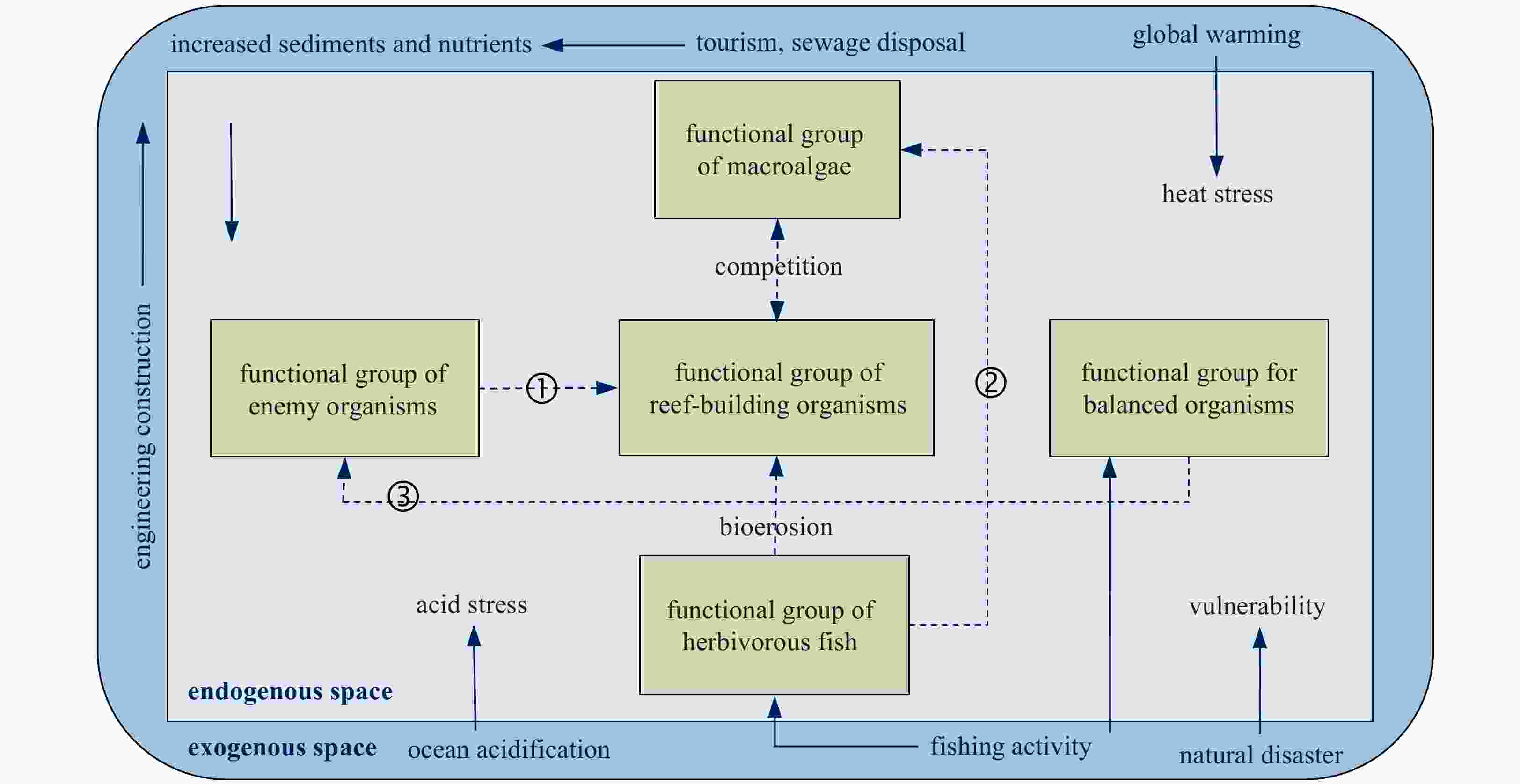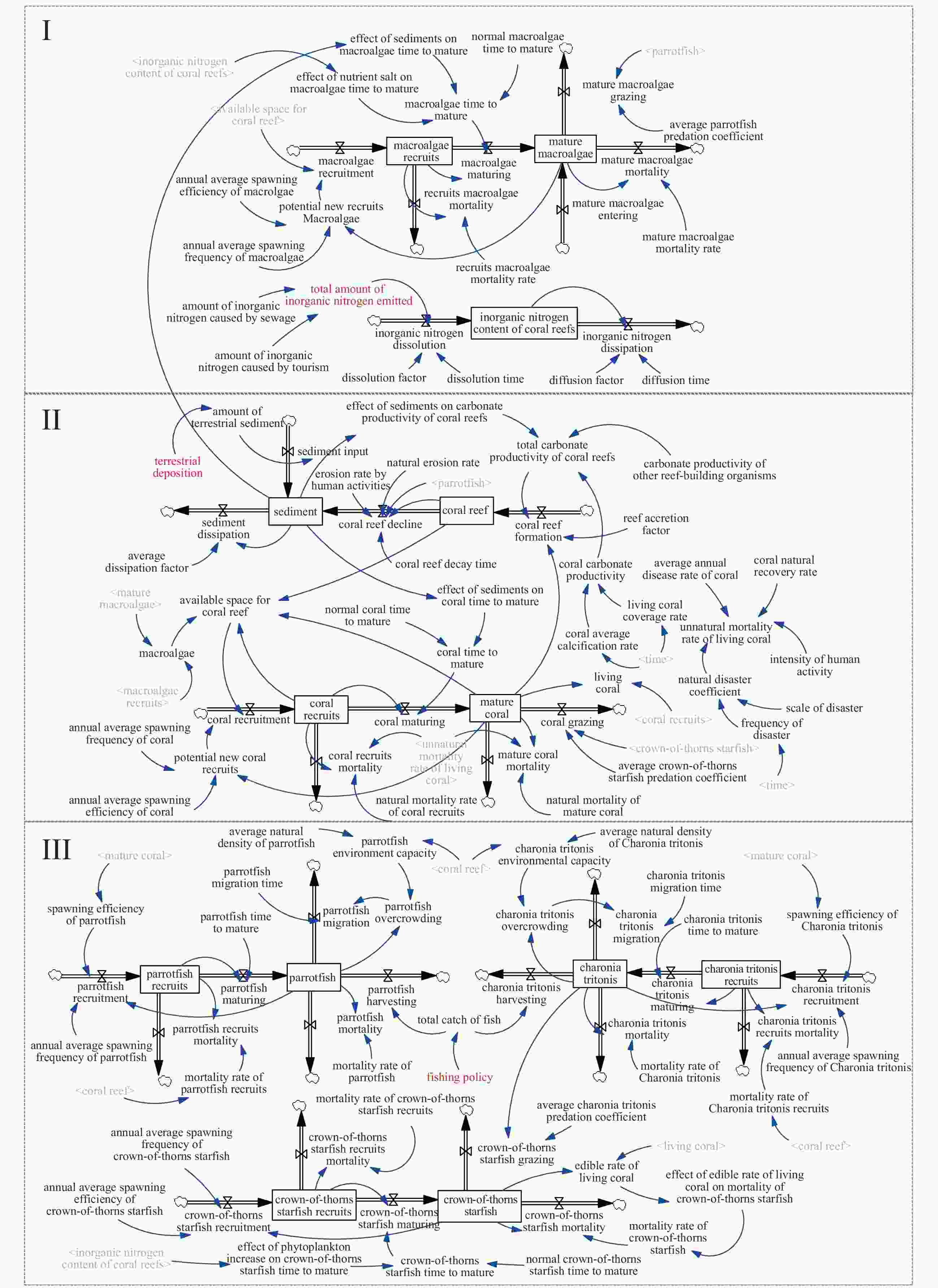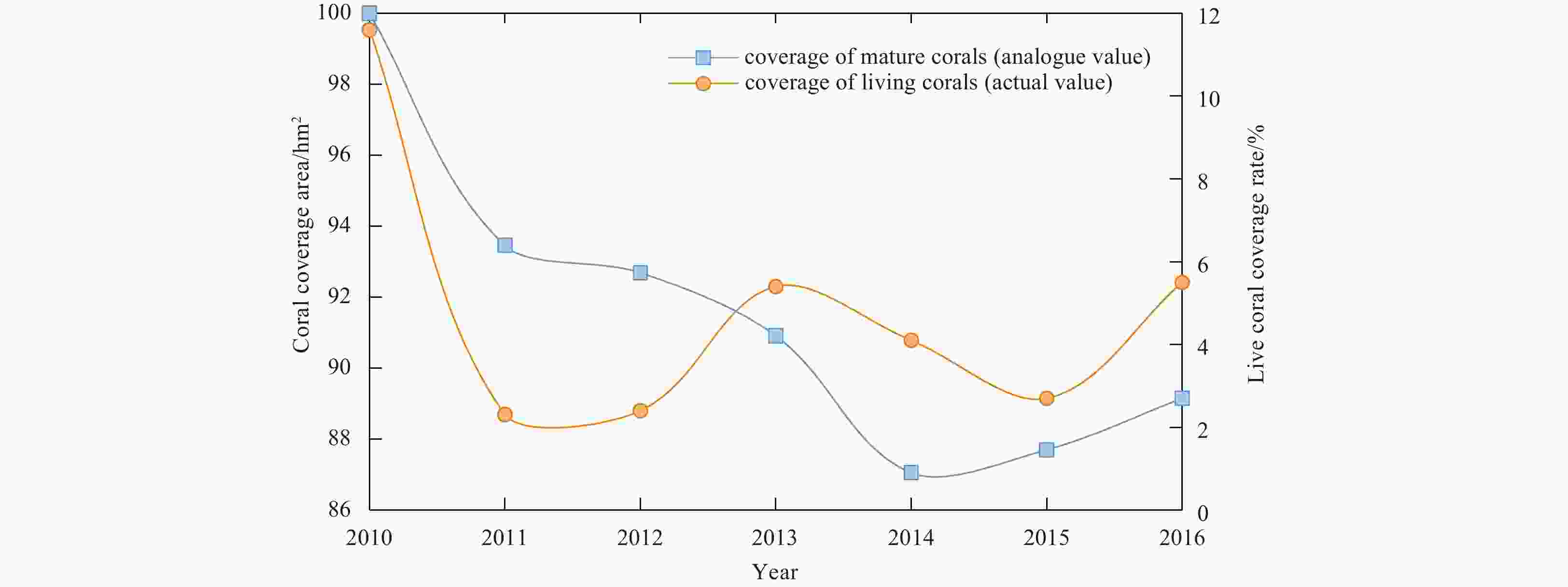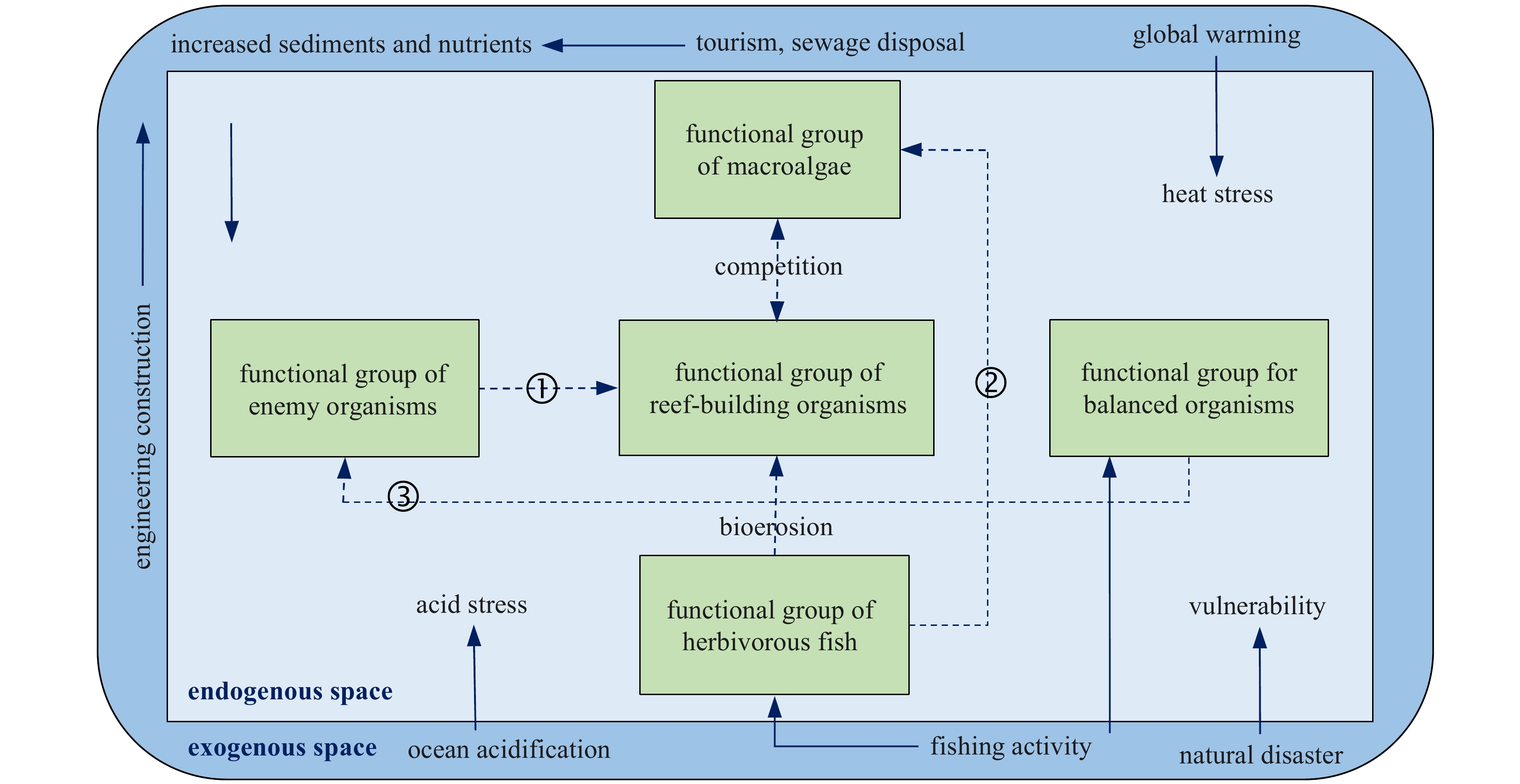Dynamic simulation of tropical coral reef ecosystem being disturbed by multiple situations
-
Abstract: In consideration of the rapid degradation of coral reef ecosystems, the establishment of models is helpful to comprehend the degradation mechanism of coral reef ecosystems and predict the development process of coral reef communities. According to the characteristics of complex ecosystem of tropical coral reefs in China, the coral reef functional group is the core level variable; combined with the multiple feedback effects of coral reef functional groups and environmental changes, the study presents a coral reef ecosystem dynamics model with hermatypic corals as the core. Based on the simulation of the assumed initial value and the internal feedback of the system, the results show that in the basic simulation (relative health conditions), the coverage area of live corals and coral reefs generally decreased first and then increased, and increased by 4.67% and 6.38% between 2010 and 2050, respectively. Based on the calibration model and the current situation of the studied area, the multi-factor disturbance effects of coral reef communities were simulated and explored by setting up three scenarios involving fishing policy, terrestrial deposition, and inorganic nitrogen emissions. Among them, in the single factor disturbance, the fishing policy exerts the most direct impact on the community decline; and the succession phenomenon is obvious; the terrestrial sedimentation has a faster and more integrated effect on the community decline; the effect of inorganic nitrogen emission on the community decline is relatively slow. In the double/multi-factor disturbance, the superimposed disturbance will aggravate the multi-source feedback effect of the coral reef communities development, accelerate the community decay rate, and make its development trajectory more complicated and diverse. This method provides a scientific and feasible method for simulating the damage of long-term coral reef community and exploring the development law and adaptive management of coral reef ecosystems. In the future, it can be further studied in the ecological restoration process and decision-making direction of coral reefs.
-
Key words:
- coral reef ecosystem /
- system dynamics /
- situational disturbance /
- simulation
-
Figure 6. Impact of double factors disturbance on the functional groups of coral reef ecosystem, the combination of factors are fishing policy and terrestrial deposition (scenarios F4), fishing policy and total amount of inorganic nitrogen emissions (scenarios F5), terrestrial deposition and total amount of inorganic nitrogen emissions (scenarios F6).
Table 1. Functional groups and major organisms of coral reef ecosystems
Functional groups Interpretation Representative creature Reef-building organisms the main builder of coral reefs, organisms which have the
ability to build reefshermatypic corals and other
reef-building organismsMacroalgae an important part of the coral reef which competes
with corals, especially in spacelarge fleshy seaweed, such as leafy seaweed,
cortical large seaweedHerbivorous fish predators of macroalgae parrotfish Enemy organisms predators of hermatypic corals crown-of-thorns starfish Balanced organisms predators of the enemies of hermatypic corals charonia tritonis Table 2. Main variables and expressions of the coral reef SD model
Module Variable name Type Equation expression I coral recruitment area/(104 m2) RV =MIN (potential new coral recruitment, available space for coral reef) coral grazing area/(104 m2) RV =MAX (crown-of-thorns starfish stock×average crown-of-thorns starfish predation coefficient, 0) coral carbonate productivity/(kg·a–1·m–2) AV =living coral coverage rate×coral average calcification rate coral reef decline/(104 m2) RV =coral reef stock/coral reef decay time+coral reef stock×(erosion rate by human activities+natural erosion rate)+parrotfish stock×3×10-7 sediment/(104 m2) LV =INTEG (sediment input+coral reef decline stock–sediment dissipation, 10) available space for coral reef/(104 m2) AV =coral reef stock-(coral recruitment+mature coral stock+macroalgae stock) effect of sediment on carbonate productivity of coral reefs AV =WITH LOOKUP {sediment, ([(0, 0)–(40, 1)], (0, 1),(5, 0.8), (10, 0.6), (15, 0.4), (20, 0.1), (30, 0), (40, 0)} II inorganic nitrogen content of coral
reef/(mg·L–1)LV =INTEG (inorganic nitrogen dissolution–inorganic nitrogen dissipation, 0.02) potential new recruits macroalgae/(104 m2) AV =mature macroalgae stock×annual average spawning efficiency of macroalgae×annual average spawning frequency of macroalgae macroalgae recruitment/(104 m2) RV =MIN (available space for coral reef, potential new macroalgae recruitment) macroalgae time to mature/a AV =normal macroalgae time to mature×effect of nutrients on macroalgae time to mature×effect of sediment on macroalgae time to mature effect of nutrients on macroalgae time to mature AV =WITH LOOKUP (inorganic nitrogen content of coral reef, {[(0, 0)–(5, 1)], (0, 1), (1, 0.5), (2, 0.4), (15, 0.4), (3, 0.3), (4, 0.2), (5, 0.1)} III parrotfish overcrowding/ind. AV =MAX(0, parrotfish stock–parrotfish environmental capacity) spawning efficiency of parrotfish AV =WITH LOOKUP (mature coral stock, ([(0, 0)–(350, 0.8)], (0, 0.1),(100, 0.4), (150, 0.45), (200, 0.5), (250, 0.55), (300, 0.6), (350, 0.65)) parrotfish recruits mortality AV =WITH LOOKUP(coral reef stock, ([(0, 0.6)–(1000, 1)], (0, 0.9), (200, 0.85), (400, 0.8), (600, 0.75), (800, 0.7), (1000, 0.65)) crown-of-thorns starfish time to mature/a AV =nomal crown-of-thorns starfish time to mature×effect of phytoplankton
increase on crown-of-thorns starfish time to matureNote: The first column indicates the submodule to which the variable belongs, where I is a coral submodule, II is a macroalgae submodule, III is another biological submodule; and the third column represents the variable type, where LV is the level variable, RV is the rate variable, and AV is the auxiliary variable. INTEG, WITH LOOKUP are functional expressions in System Dynamics Vensim software. Table 3. Main parameters and sources of the model
No. Method Main parameter Value Reference 1 Relevant literature determination or estimation average annual spawning frequency of corals/(ind.∙a–1) 1 Zhang et al. (2013) annual natural mortality of living corals/ind. 0.1 Huang et al. (2012); Zhou et al. (2017) average annual disease rate of corals/ind. 0.1 Huang et al. (2012); Zhu et al. (2012) normal time for corals to mature/a 1 Huang et al. (2011); Shen et al. (2014) average predation coefficient of crown-of-thorns starfish/(104 m2∙ind.–1) 0.001 825 Bartelet (2017) average coral calcification rate/(g·cm–2·a–1) – Shi et al. (2009); Zhang and Chen (2006) 2 Statistical yearbook and bulletin of the state of the marine environment live coral coverage rate/ind. – National Bureau of Statistics of the People’s Republic of China (2010–2016); South China Sea Bureau of Natural Resources Ministry (2013–2017) frequency of disasters/ind. – inorganic nitrogen content of coral reefs/(mg∙L–1) – 3 Table function determination the effects of sediments on the carbonate productivity of coral reefs, the influence of sediments on the time corals and macroalgae need to mature, the effects of nutrients on the time macroalgae need to mature, et cetera/ind. – Szmant (2002); Fabricius et al. (2003);
Zou and Xia (2011)4 Delphi method, trend extrapolation method decay time of the coral reef/a 500 – average dissipation factor/ind. 0.25 – inorganic nitrogen dissolution factor/ind. 15 – inorganic nitrogen diffusion factor/ind. 10 – 5 Simulation trial method reef accretion factor/ind. 0.001 8 the result of multiple simulation
based on the modelnatural recovery rate of coral/ind. 0.03 – intensity of human activities/ind. 0.1 – Table 4. Scenario design parameter settings
No. Variables Current value Adjusted value Relevant equations Interpretation of the variable Threshold A Threshold B 1 Fishing policy ontrol variable 1 2 3 total number of captured fish=RANDOM UNIFORM (8 000, 12 000, 1)×fishing policy control variable an indicator of the fishing intensity; the larger value, the more average annual catch 2 Terrestrial deposition 1 1.5 2.5 amount of terrestrial deposition =RANDOM UNIFORM (0, 5, 1)× amount of terrestrial deposition represents sediments discharged from land to sea; the greater the value, the more sediments are inputted 3 Total amount of inorganic nitrogen emissions/(mg∙L-1) 0.2 2 4.5 amount of inorganic nitrogen emissions=inorganic nitrogen caused by emissions + inorganic nitrogen caused by tourism the inorganic nitrogen emissions by human activities; the greater the value, the more inorganic nitrogen is dissolved into the coral reef -
[1] Baker A C, Glynn P W, Riegl B. 2008. Climate change and coral reef bleaching: An ecological assessment of long-term impacts, recovery trends and future outlook. Estuarine, Coastal and Shelf Science, 80(4): 435–471. doi: 10.1016/j.ecss.2008.09.003 [2] Bartelet H A. 2017. Coral Reef Dynamics. Amsterdam: DynaMundo Publishing, 34–37 [3] Bellwood D R, Hoey A S, Ackerman J L, et al. 2006. Coral bleaching, reef fish community phase shifts and the resilience of coral reefs. Global Change Biology, 12(9): 1587–1594. doi: 10.1111/j.1365–2486.2006.01204.x [4] Bongiorni L, Giovanelli D, Rinkevich B, et al. 2011. First step in the restoration of a highly degraded coral reef (Singapore) by in situ coral intensive farming. Aquaculture, 322–323: 191–200. doi: 10.1016/j.aquaculture.2011.09.024 [5] Branchini S, Pensa F, Neri P, et al. 2015. Using a citizen science program to monitor coral reef biodiversity through space and time. Biodiversity and Conservation, 24(2): 319–336. doi: 10.1007/s10531–014-0810–7 [6] Carpenter K E, Abrar M, Aeby G, et al. 2008. One-third of reef-building corals face elevated extinction risk from climate change and local impacts. Science, 321(5888): 560–563. doi: 10.1126/science.1159196 [7] Chang Y C, Hong F W, Lee M T. 2008. A system dynamic based DSS for sustainable coral reef management in Kenting coastal zone, Taiwan. Ecological Modelling, 211(1–2): 153–168. doi: 10.1016/j.ecolmodel.2007.09.001 [8] Fabricius K E. 2005. Effects of terrestrial runoff on the ecology of corals and coral reefs: review and synthesis. Marine Pollution Bulletin, 50(2): 125–146. doi: 10.1016/j.marpolbul.2004.11.028 [9] Fabricius K E, Wild C, Wolanski E, et al. 2003. Effects of transparent exopolymer particles and muddy terrigenous sediments on the survival of hard coral recruits. Estuarine, Coastal and Shelf Science, 57(4): 613–621. doi: 10.1016/S0272–7714(02)00400–6 [10] Grossman L A. 2014. The impact of sea surface temperature on outbreaks of Acanthaster planci on the Great Barrier Reef. Scripps Senior Theses, Paper 306 [11] Heron S F, Eakin C M, Fanny D, et al. 2017. Impacts of Climate Change on World Heritage Coral Reefs: A First Global Scientific Assessment. Paris: UNESCO World Heritage Centre [12] Holmes G, Johnstone R W. 2010. Modelling coral reef ecosystems with limited observational data. Ecological Modelling, 221(8): 1173–1183. doi: 10.1016/j.ecolmodel.2010.01.010 [13] Huang Hui, Dong Zhijun, Lian Jiansheng. 2008. Establishment of nature reserve of coral reef ecosystem on the Xisha Islands. Tropical Geography (in Chinese), 28(6): 540–544. doi: 10.13284/j.cnki.rddl.001090 [14] Huang Hui, You Feng, Lian Jiansheng, et al. 2012. Composition and distribution of scleractinian coral in the northwest of Hainan Island. Marine Sciences (in Chinese), 36(9): 64–74 [15] Huang Jieying, Huang Hui, Zhang Yuyang, et al. 2011. Embryonic and larval development of Montipora turgescens and Acropora robusta. Journal of Tropical Oceanography (in Chinese), 30(2): 67–73 [16] Hughes T P, Graham N A J, Jackson J B C, et al. 2010. Rising to the challenge of sustaining coral reef resilience. Trends in Ecology and Evolution, 25(11): 633–642. doi: 10.1016/j.tree.2010.07.011 [17] Kubicek A, Reuter H. 2016. Mechanics of multiple feedbacks in benthic coral reef communities. Ecological Modelling, 329: 29–40. doi: 10.1016/j.ecolmodel.2016.02.018 [18] Li Xiubao, Huang Hui, Lian Jiansheng, et al. 2007. Progress of adaptive mechanism of coral and symbiotic algae during bleaching. Acta Ecologica Sinica (in Chinese), 27(3): 1217–1225 [19] Li Yuanchao, Chen Shiquan, Zheng Xinqing, et al. 2018. Analysis of the change of hermatypic corals in Yongxing Island and Qilianyu Island in nearly a decade. Haiyang Xuebao (in Chinese), 40(8): 97–109. doi: 10.3969/ji.ssn.0253–4193.2018.08.010 [20] Li Yuanchao, Huang Hui, Dong Zhijun, et al. 2008. Headway of study on coral reefs ecological restoration. Acta Ecologica Sinica (in Chinese), 28(10): 5047–5054 [21] Li Yuanchao, Liu Yilin, Huang Jieying, et al. 2015. Feasibility study on restoration of coral reef ecosystem in Xisha Islands. Ocean Development and Management (in Chinese), 32(1): 101–103 [22] Liao Zhiheng, Yu Kefu, Wang Yinghui. 2016. Review on the effect of macroalgae on the degeneration of coral reefs. Acta Ecologica Sinica (in Chinese), 36(21): 6687–6695. doi: 10.5846/stxb201505040909 [23] Liu Xiaoqian, Pei Tao, Zhou Chenghu, et al. 2018. A systems dynamic model of a coal-based city with multiple adaptive scenarios: A case study of Ordos, China. Science China Earth: Sciences, 61(3): 302–316. doi: 10.1007/s11430–016-9077–5 [24] Liu Yong, Zhou Feng, Guo Huaicheng, et al. 2006. Management-oriented characterization of lake ecosystem dynamics. Acta Ecologica Sinica (in Chinese), 26(10): 3434–3441 [25] Moran P J, De'ath G. 1992. Estimates of the abundance of the crown-of-throns starfish Acanthaster planci in outbreaking and non-outbreaking populations on reefs within the Great Barrier Reef. Marine Biology, 113: 509–515. doi: 10.1007/BF00349178 [26] National Bureau of Statistics of the People's Republic of China. 2010–2016. China Fishery Statistical Yearbook. Beijing: China Agricultural Publishing House [27] Precht W F. 2006. Coral Reef Restoration Handbook. Boca Raton, Florida, USA: CRC Press [28] Qin Zhenjun, Yu Kefu, Wang Yinghui. 2016. Review on ecological restoration theories and practices of coral reefs. Tropical Geography (in Chinese), 36(1): 80–86. doi: 10.13284/j.cnki.rddl.002809 [29] Ramos-Scharrón C E, Torres-Pulliza D, Hernández-Delgado E A. 2015. Watershed- and island wide-scale land cover changes in Puerto Rico (1930s–2004) and their potential effects on coral reef ecosystems. Science of the Total Environment, 506–507: 241–251. doi: 10.1016/j.scitotenv.2014.11.016 [30] Rinkevich B. 2005. Conservation of coral reefs through active restoration measures: recent approaches and last decade progress. Environmental Science and Technology, 39(12): 4333–4342. doi: 10.1021/es0482583 [31] Shen Yuchun, Yang Xiaodong, Liu Li, et al. 2014. Gonadal development and fecundity of corals Porites lutea, Goniopora djiboutiensis, and Galaxea fascicularis in South China Sea. Oceanologia et Limnologia Sinica (in Chinese), 45(2): 314–321. doi: 10.11693/hyhz20121112002 [32] Shi Qi, Zhao Meixia, Zhang Qiaomin, et al. 2009. Estimate of carbonate production by scleractinian corals at Luhuitou fringing reef, Sanya, China. Chinese Science Bulletin, 54(4): 696–705. doi: 10.1007/s11434–008-0533–9 [33] Shlesinger T, Loya Y. 2016. Recruitment, mortality, and resilience potential of scleractinian corals at Eilat, Red Sea. Coral Reefs, 35(4): 1357–1368. doi: 10.1007/s00338–016-1468–2 [34] Sterman J D. 2000. Business Dynamics: Systems Thinking and Modeling for a Complex World. Boston: Irwin/McGraw-Hill, doi: 10.1057/palgrave.jors.2601336 [35] South China Sea Bureau of Natural Resources Ministry. 2013−2017. Bulletin on the state of the marine environment of the South China Sea in 2012−2016. http://scs.mnr.gov.cn/scsb/gbytj/list.shtml [2019-06-15] [36] Szmant A M. 2002. Nutrient enrichment on coral reefs: Is it a major cause of coral reef decline?. Estuaries, 25(4): 743–766. doi: 10.1007/BF02804903 [37] Talbot F, Wilkinson C. 2001. Coral Reefs, Mangroves and Seagrasses: a Sourcebook for Managers. Townsville, AU: Australian Institute of Marine Sciences [38] Tu Qiang. 2007. Xisha coral reef is eroded by a large number of crown-of-thorns starfish. Ocean World (in Chinese), (6): 4 [39] Wang Daoru, Wang Huajie, Li Yuanchao, et al. 2011. Preliminary study of coral larvae supplementary source around Leizhou Peninsula. Journal of Tropical Oceanography (in Chinese), 30(2): 26–32 [40] Wang Lirong, Yu Hongbin, Li Cuitian, et al. 2018. Progress in marine ecosystem restoration. Journal of Applied Oceanography (in Chinese), 37(3): 435–446. doi: 10.3969/J.ISSN.2095–4972.2018.03.017 [41] Wilkinson C. 2008. Status of coral reefs of the world: 2008—Global coral reef monitoring network and reef and rainforest research center. Coral Reefs, (3): 296 [42] Wilkinson C R. 2004. Status of the Coral Reefs of the World: 2004. Vol 2. Townsville: Australian Institute of Marine Science [43] Wu Zhongjie, Wang Daoru, Tu Zhigang, et al. 2011. The analysis on the reason of hermatypic coral degradation in Xisha. Haiyang Xuebao (in Chinese), 33(4): 140–146 [44] Yu Kefu. 2012. Coral reefs in the South China Sea: Their response to and records on past environmental changes. Science China: Earth Sciences, 55(8): 1217–1229. doi: 10.1360/zd-2012–42-8–1160 [45] Zhang Yuanhui, Chen Liqi. 2006. Response of coral reef in Nansha waters to increasing atmospheric CO2. Journal of Oceanography in Taiwan Strait (in Chinese), 25(1): 68–76 [46] Zhang Yuyang, Huang Hui, Huang Jieying, et al. 2013. Xisha Islands coral larvae cultivation experiment. Ocean Development and Management (in Chinese), 30(Z1): 78–82 [47] Zhang Zhendong, Shao Kuishuang, Yang Zhengxian, et al. 2018. Evaluation of the Xisha coral reef ecosystem carrying capacity. Marine Environmental Science (in Chinese), 37(4): 487–492 [48] Zhao Huanting, Wang Lirong, Yuan Jiayi. 2016. Sustainable development of the coral reefs in the South China Sea Islands. Tropical Geography (in Chinese), 36(1): 55–65. doi: 10.13284/j.cnki.rddl.002800 [49] Zhao Meixia, Jiang Dapeng, Zhang Qiaomin. 2017. Review on the study of coral cay dynamics and its stability. Tropical Geography (in Chinese), 37(5): 694–700. doi: 10.13284/j.cnki.rddl.002988 [50] Zhao Meixia, Yu Kefu, Zhang Qiaomin. 2006. Review on coral reefs biodiversity and ecological function. Acta Ecologica Sinica (in Chinese), 26(1): 186–194 [51] Zhou Hongying, Yao Xuemei, Li Li, et al. 2017. Scleractinian coral community structure and distribution in the coastal waters surrounding Hainan Island. Biodiversity Science (in Chinese), 25(10): 1123–1130. doi: 10.17520/biods.2017079 [52] Zhou Jin, Jin Hui, Cai Zhonghua. 2014. A review of the role and function of microbes in coral reef ecosystem. Chinese Journal of Applied Ecology (in Chinese), 25(3): 919–930. doi: 10.13287/j.1001-9332.2014.0066 [53] Zhu Zhixiong, Zhou Yongcan, Ke Shaowen, et al. 2012. The survey and preliminary research on main diseases of stony coral in Xisha Archipelago. Haiyang Xuebao (in Chinese), 34(6): 195–204 [54] Zou Dinghui, Xia Jianrong. 2011. Nutrient metabolism of marine macroalgae and its relationship with coastal eutrophication: A review. Chinese Journal of Ecology (in Chinese), 30(3): 589–595. doi: 10.13292/j.1000–4890.2011.0076 -





 下载:
下载:









